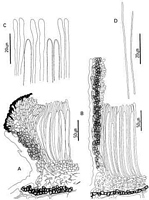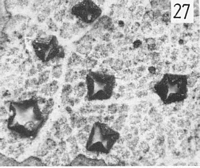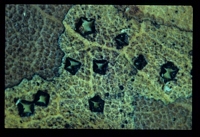|
 Coccomyces limitatus Coccomyces limitatus
SynonymsPhacidium limitatum
BiostatusPresent in region - Indigenous. Non endemic
Images (click to enlarge)
Caption: Fig. 11. Coccomyces limitatus: A, ascocarp margin in cross-section. B, immature ascocarp
margin in cross-section. C, apices of asci and paraphyses. D, released ascospores. | 
Caption: Fig. 12 Anamorph of Coccomyces limitatus: pycnidium in cross-section. | 
Caption: Fig. 27 Macroscopic appearance of ascocarp (x 12).
Coccomyces limitatus | 
Owner: Herb. PDD | |
Article: Johnston, P.R. (1986). Rhytismataceae in New Zealand. 1. Some foliicolous species of Coccomyces de Notaris and Propolis (Fries) Corda. New Zealand Journal of Botany 24(1): 89-124 (http://www.rsnz.org/publish/abstracts.php).
Description: Ascocarps developing in pale brown or yellow lesions on fallen leaves. Lesions surrounded
by a continuous, narrow, black zone line. Ascocarps angular in outline, 3-5 sided, 0.4-1.2 mm
diam. Immature ascocarps with dark grey to black walls, with well developed paler zones
along future lines of opening, and adjacent to outside edge of ascocarp. Mature ascocarps
with walls black to dark brown, with a well developed paler zone adjacent to outside edge of
ascocarp. Lips absent. Hymenium pale lemon-yellow when exposed. Pycnidia lenticular,
walls pale, with a brown line around edge and around the single, round ostiole.
Ascocarp intraepidermal. In vertical section upper stromatal layer 20-40 µm wide, not
extending as far as the lower wall. Small cap of dense, black tissue around opening, otherwise
of brown to dark brown, pseudoparenchymatous cells, 4-7 µm diam. Lower stromatal layer
8-15 µm wide, of 1-2 layers of thick walled, brown to dark brown, more or less globose
cells, 5-10 µm diam. Subhymenium 10-20 µm wide, of thin walled, hyaline, globose cells,
7- 10 µm diam., a layer, up to 50 µm wide, of loose hyphae and crystals present between
subhymenium and lower wall. Excipulum becoming well developed, up to 50 µm wide,
arising from inner layers of upper wall, comprising several rows of hyaline, closely septate
hyphae, becoming slightly swollen and covered by a dark brown substance at apices.
Excipulum formed after the ascocarps have opened, and may not be apparent in young,
recently opened ascocarps. In young ascocarps has the appearance of a well developed layer
of short, hyaline, cylindric periphyses. These become longer and develop septa to form the
excipulum.
Paraphyses 2-3 µm diam., gradually increasing in width to 3.5-4.5 µm diam. at apices,
extending 15-20 µm beyond asci. Asci cylindric, tapering slightly to a rounded apex, 95-125
x 4-5(-5.2) µm, either uniformly thin walled, or sometimes with an apical thickening, with a
short, broad pore, non-amyloid, 8-spored. Ascospores filiform, 44-75 x 0.8-1.0 µm, straight
or irregularly curving when released, not tapering, 0-1 septate, gelatinous sheath poorly
developed.
Pycnidia intraepidermal, lenticular. Lower wall 8- 10 µm wide, of 2-3 layers of thick
walled, dark brown, flattened cells, 2-4 µm diam. Upper wall almost obsolete, consisting of
a few hyaline, thin walled cells beneath the cuticle, and a small group of dark walled cells
around the ostiole. Conidiogenous layer not seen (see notes below).
Habitat: HABITAT: Found on fallen leaves of Knightia excelsa, Pseudopanax species, Astelia
solandri A. Cunn., Clematis paniculata Gmel., Elaeocarpus dentatus J. R. et G. Forst.)
Vahl., Metrosideros fulgens, and Weinmannia racemosa. Although found on a wide range of
host plants, most collections were found on either Knightia excelsa (12) or Pseudopanax
species (4).
Has previously been reported on various hosts from Central and South America, and Java
(Sherwood 1980).
Notes: The pycnidia assumed to be those of the C. limitatus anamorph were found in association with the teleomorph in all collections. The pycnidia are typical in structure of Leptostroma, but all those examined were sterile. Many Rhytismataceous taxa form an anamorph and teleomorph within the same lesion, but at different times. It is not possible to identify C. limitatus unless the teleomorph state is present, as its most common host species also provide a substrate for a number of other Rhytismataceous taxa with similar anamorphs.
C. limitatus is the only species of Coccomyces found in New Zealand with ascospores less than 1.0 µm wide. It is similar to a number of the species included in the "C. leptosporus complex" described by Sherwood (1980). Species in this group which have 3-4 sided, angular ascocarps are C. tesselatus Sherwood (Thaxter 2612, on unidentified leaves, Grand Etang, Grenada, Thaxter 1912-13 - FH; Pfister 844, on unidentified leaves, Guadeloupe, Pfister, Carpenter, Sherwood, 4.1.1974 paratype - FH), C. antillarum (see specimens cited under C globosus), C philippinus (Schmidt & Kunze) Karsten (Baker, Fungi Malayana, on Neolitsea, Mt. Maquiling, Prov. Laguna, Philippines, June 1914 - type - S), and C. limitatus. C. limitatus can be separated from these other species by its very narrow asci (4-5.5 µm wide) and by its paraphyses which are broad along their entire length, rather than being swollen near the apex.
The type specimen of C limitatus has ascocarps lacking an excipulum, and asci slightly wider (5-6 µm) than those found in New Zealand collections. However the type specimen is quite small, and in all other respects, both macroscopic and microscopic, is identical to the New Zealand fungus. Other collections from South America cited by Sherwood as C. limitatus (e.g., NY-VE2112) did have narrower asci, and an excipulum developing in the same way as that described above for the New Zealand collections.
|